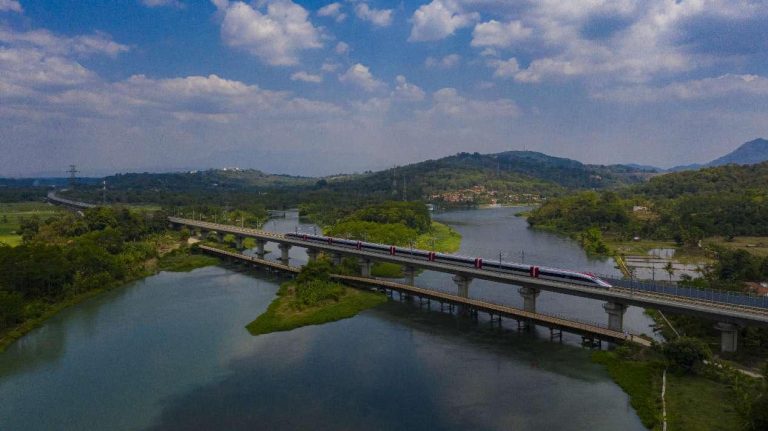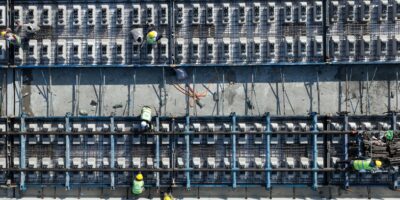
By Zhang Niansheng, Liu Hui, The Jakarta-Bandung High-Speed Railway connects the Indonesian capital Jakarta with the popular tourist city of Bandung. Spanning a total of 142 kilometers, it is the first high-speed railway in Indonesia and Southeast Asia, a signature of China-Indonesia Belt and Road cooperation and a flagship project of the practical cooperation between the two countries.
The high-speed railway offers Indonesian passengers a safer, greener, more efficient and more comfortable mode of transportation, providing them with delightful travel experiences. With its excellent services, the high-speed railway has become highly favored by the public.
According to statistics, the Jakarta-Bandung High-Speed Railway has served a total of 383,000 passenger trips as of Nov. 17, one month after its official opening. The highest daily passenger occupancy rate reached 98.7 percent, indicating tremendous growth in passenger traffic.
The Halim Station, where the high-speed railway starts, is always packed with passengers and surrounded by busy shops.
A passenger named Riswanto told People’s Daily that he and his wife came all the way here to take a ride along the Jakarta-Bandung High-Speed Railway.
“The Jakarta-Bandung High-Speed Railway was built with the assistance and advanced technology from China. We are very grateful,” he said.
“The highway from Jakarta to Bandung is heavily congested. In the past, it took three and a half hours by car to travel between the two cities. With the high-speed railway, the trip has been shortened to only 40 minutes, greatly improving transportation between the two cities,” he noted.
Olivia is an employee of an Indonesian fintech company that provides the electronic payment system for the Jakarta-Bandung High-Speed Railway.
According to her, with tickets still hard to come by, many haven’t yet had the opportunity to take a ride, but excitement runs high across the country as people speak proudly of this new high-speed railway, the first of its kind in Southeast Asia.
“On social media, people are sharing videos of their rides, showcasing the fast, smooth, and comfortable experience offered by the Jakarta-Bandung High-Speed Railway,” Olivia said.
Walking onto the platform, one will be attracted by the sleek lines of the bullet trains on the tracks and their vibrant red and white paint. The red polygon pattern at the connection between the locomotive and the carriages is inspired by the texture of the Komodo dragon, a national treasure of Indonesia. The gray seats mirror the famous Borobudur temple in Indonesia. The “Made in China” train just perfectly incorporates Indonesian local elements.
“The train for the Jakarta-Bandung High-Speed Railway is tailor-made for Indonesia, integrating Indonesia’s local culture and adapting to the local operating environment. It is technologically advanced, intelligent, safe, comfortable and environmentally friendly,” said Zhang Fangtao, chief designer of the train.
Shortly after People’s Daily reporters boarded, the train slowly pulled out and accelerated. The real-time speed of the train was displayed digitally inside the carriage, and the top speed hit 350 kilometers per hour. A water bottle placed upside down on a windowsill remained steady throughout the journey.
From the commencement of construction in June 2018 to the official opening of the railway on Oct. 17 this year, constructors from China and Indonesia joined forces to overcome challenges, working tirelessly for nearly 2,000 days. Together, they have holed through 13 tunnels and erected 56 bridges.
In response to the frequent earthquakes in Indonesia, the high-speed trains are equipped with a specialized earthquake early warning system.
To address the impact of high temperature, high humidity, and salty climate on the service life of the trains, the technical team conducted in-situ tests for two years, evaluating hundreds of body materials and coating samples, and finally tailored a corrosion prevention solution.
In order to adapt to the complex terrain along the route, more than ten versions of train network control software and traction software were developed, which led to the trains’ excellent acceleration capabilities.
“The collaboration between the Chinese and Indonesian contracting companies overcame various difficulties and obstacles in the construction,” said Dwiyana Slamet Riyadi, President Director of PT Kereta Cepat Indonesia China, or Indonesia China High-speed Railways Limited, adding that the railway serves as an outstanding example of bilateral cooperation between Indonesia and China.
The Java Island, on which the Jakarta-Bandung High-Speed Railway is built, is home to about 150 million people, over half of Indonesia’s population. It is the most economically and culturally developed region in the country.
Ridwan Kamil, former governor of Indonesia’s West Java Province, believes that the high-speed railway not only brings personnel exchanges, but also creates opportunities, saying it will create new economic opportunities and more job positions.
According to incomplete statistics, the Jakarta-Bandung High-Speed Railway has so far created 51,000 job opportunities in Indonesia. It is estimated that the passenger services, equipment maintenance, and related supporting industries will generate 30,000 additional jobs upon the operation of the railway.
Moreover, more than 75 percent of the services and procurement for the high-speed railway are sourced locally, which significantly boosts the local supply chain and employment. In particular, the project has trained thousands of qualified technicians, laying a solid foundation for its long-term and stable operation.
It is reported that during the construction of the Jakarta-Bandung High-Speed Railway, the Chinese side, by establishing training institutions, conducting on-site training and carrying out a mentoring mechanism, has trained over 45,000 Indonesian employees.
Budi Karya Sumadi, the Minister of Transportation of Indonesia, said that the Jakarta-Bandung High-Speed Railway offers Indonesia an opportunity for technological advancement and also promotes the development of the local supporting industry chain. In addition to high-speed rail, Indonesia looks forward to further strengthening cooperation with China in areas such as aircraft manufacturing and shipping, he added.










